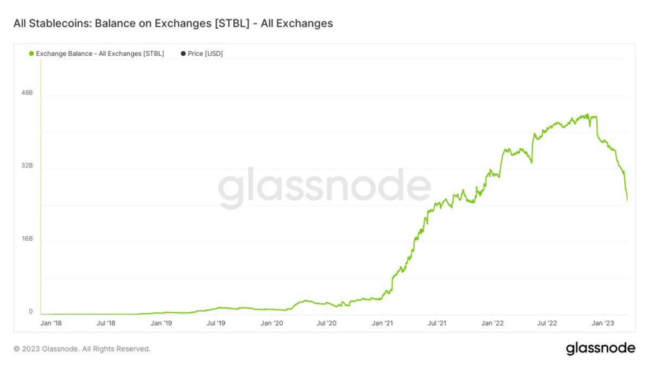Glassnode data on Mar. 26 shows that the stablecoin supply on exchanges has more than halved to less than $24b in four months.
Stablecoin supply on exchanges dropping
In November, stablecoin supply on exchanges stood at over $44b. Still, this figure, triggered by several fundamental factors, including regulatory actions, has been contracting over the months.
As of writing, only about $24b is held in various cryptocurrency exchanges. Some analysts believe that a big chunk might have been converted to other liquid crypto assets or currencies, including bitcoin (BTC) and ethereum (ETH), or solid cash like the USD.
In crypto, stablecoins track the value of other assets perceived to be stable. Stablecoins tracking fiat currencies like the USD are popular.
The common ones include USDT, a token present in multiple blockchains like Tron and Ethereum, issued by Tether Holdings. It is pegged to the USD. Its issuers claim the token is sufficiently backed by cash and cash equivalents, including United States short-term securities like Treasuries. Other alternatives include USDC by Circle, BUSD by Paxos, and DAI, an algorithmic stablecoin by MakerDAO minted only on Ethereum.
Historically, stablecoins have served as conduits, allowing users to channel funds from traditional finance to the cryptocurrency market.
Since stablecoins are theoretically “stable” and divergent from crypto assets like bitcoin, which are volatile, tokens like DAI, USDT, and USDC can act as shields when crypto prices are under liquidation pressure.
Regulatory changes and stablecoins de-pegging
There could be several explanations behind the sharp contraction of stablecoin supply on exchanges.
Last month, the New York Department of Financial Services (NYDFS) ordered Paxos, the issuer of BUSD, a stablecoin, to halt the minting of new tokens. It comes hours after the United States Securities and Exchange Commission (SEC) issued a Wells Notice to Paxos, claiming that BUSD was a security. This forced BUSD holders to convert to other stablecoins and assets, mostly USDT and USDC.
Days later, the bank run at Silicon Valley Bank (SVB) impacted Circle, the issuer of USDC. Circle had $3.3b stuck in SVB. This triggered panic in the markets, forcing USDC to de-peg as users rushed to exit for USDT, which at that time was trading at a premium. The exit from USDC also impacted DAI, which de-pegged.
Analysts point out that the destabilization of stablecoins and increasing regulatory pressure may be why token holders could be exiting to currencies of legacy networks, including bitcoin. When writing on Mar. 26, bitcoin is trading at $27,831, up 15% in the last month.



